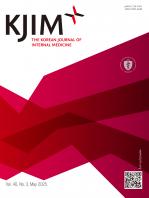|
Hemato-oncology / Original Article
Prognostic Significance Of Sequential 18f-fdg Pet/Ct During Frontline Treatment Of Peripheral T Cell Lymphomas
Ga-Young Song, Sung-Hoon Jung, Seo-Yeon Ahn, Mihee Kim, Jae-Sook Ahn, Je-Jung Lee, Hyeoung-Joon Kim, Jang Bae Moon, Su Woong Yoo, Seong Young Kwon, Jung-Joon Min, Hee-Seung Bom, Sae-Ryung Kang, Deok-Hwan Yang
Korean J Intern Med. 2024;39(2):327-337. Published online January 25, 2024
Background/Aims: The prognostic significance of 18F-fluorodeoxyglucose (FDG)-positron emission tomography-computed tomography (PET/CT) in peripheral T-cell lymphomas (PTCLs) are controversial. We explored the prognostic impact of sequential 18F-FDG PET/CT during frontline chemo..
|
|
|
Infectious diseases / Original Article
Eosinophil-mediated lung inflammation associated with elevated natural killer T cell response in COVID-19 patients
Dong-Min Kim, Jun-Won Seo, Yuri Kim, Uni Park, Na-Young Ha, Hyoree Park, Na Ra Yun, Da Young Kim, Sung Ho Yoon, Yong Sub Na, Do Sik Moon, Sung-Chul Lim, Choon-Mee Kim, Yeon-Sook Kim, Nam-Hyuk Cho
Korean J Intern Med. 2022;37(1):201-209. Published online September 27, 2021
Background/Aims: Coronavirus disease 2019 (COVID-19) is associated with acute respiratory syndrome. The mechanisms underlying the different degrees of pneumonia severity in patients with COVID-19 remain elusive. This study provides evidence that COVID-19 is associated with eosinophil-mediated inflam..
|
|
|
Rheumatology / Original Article
The evaluation of cellular immune function in elderly patients with systemic lupus erythematosus
Kun Men, Yu Chen, Jingwei Zhang, Dianjun Wei
Korean J Intern Med. 2019;34(4):932-937. Published online November 29, 2017
Background/Aims: To evaluate cellular immune function in systemic lupus erythematosus (SLE) patients over 60 years old, the association between antinuclear antibody (ANA) titers and the ratio of CD4+ /CD8+ was analyzed in this study. The distribution of ANAs and extractable nu..
|
|
|
Hemato-oncology / Original Article
Clinical characteristics, pathological distribution, and prognostic factors in non-Hodgkin lymphoma of Waldeyer’s ring: nationwide Korean study
Seong Jun Lee, Cheol Won Suh, Soon Il Lee, Won Seog Kim, Won Sik Lee, Hyo Jung Kim, Chul Won Choi, Jin Seok Kim, Jin Seok Kim, Ho-Jin Shin, Ho-Jin Shin, The Consortium for Improving Survival of Lymphoma , The Consortium for Improving Survival of Lymphoma
Korean J Intern Med. 2014;29(3):352-360. Published online April 29, 2014
Background/Aims: In Asia, the incidence of non-Hodgkin lymphoma (NHL) has increased in recent decades. Waldeyer’s ring (WR) is the most common site of NHL involving the head and neck. In this study, the pathological distribution of WR-NHL and its clinical features were analyzed retrospectiv..
|
|
|
Letter to the editor
An Adult Case of Severe Chronic Active Epstein-Barr Virus Infection with T-Cell Lymphoproliferative Disorder
Se-Kwon Mun, Seung-Sook Lee, Seung-Hwa Kang, Min-Jae Lee, So-Yeon Kim, Hyung-Gyu Choi, Hye Jin Kang
Korean J Intern Med. 2012;27(4):474-477. Published online November 27, 2012
|
|
|
Original Article
Bone Marrow T Cells are Superior to Splenic T Cells to Induce Chimeric Conversion After Non-Myeloablative Bone Marrow Transplantation
Hyun-Sil Park, Seok-Goo Cho, Min-Jung Park, So-Youn Min, Hong-Seok Chang, Hee-Je Kim, Seok Lee, Chang-Ki Min, Jong-Wook Lee, Woo-Sung Min, Chun-Choo Kim, Ho-Youn Kim
Korean J Intern Med. 2009;24(3):252-262. Published online August 26, 2009
Background/AimsThe bone marrow functions not only as the primary B-lymphocyte-producing organ but also as a secondary lymphoid organ for CD4 and CD8 cell responses and a site of preferential homing and persistence for memory T cells. Bone marrow T (BM-T) cells are distinguishe..
|
|
|
Original Article
Clinicopathologic Characteristics of T-cell Non-Hodgkin's Lymphoma: A Single Institution Experience
Ock Bae Ko, Dae Ho Lee, Sang We Kim, Jung Shin Lee, Shin Kim, Jooryung Huh, Cheolwon Suh
Korean J Intern Med. 2009;24(2):128-134. Published online June 8, 2009
Background/AimsAlthough the incidence of T-cell non-Hodgkin's lymphoma (NHL) is higher in Far East Asia than in Western countries, its incidence and clinical course in Korea are not well-defined. Therefore, we assessed the relative frequency and clinical features of T-cell NHL..
|
|
|
Original Article
Epstein-Barr Virus-Positivity in Tumor has no Correlation with the Clinical Outcomes of Patients with Angioimmunoblastic T-cell Lymphoma
Yuna Lee, Keun-Wook Lee, Jee-Hyun Kim, Soo-Mee Bang, Jong Seok Lee, Byeong-Bae Park, Won Seok Kim, Cheolwon Suh, Jung Hun Kang, Baek Yeol Ryoo, Jae Hoon Lee, Dong Bok Shin
Korean J Intern Med. 2008;23(1):30-36. Published online March 20, 2008
Background/AimsEpstein-Barr virus (EBV) is involved in the pathogenesis of angioimmunoblastic T-cell lymphoma (AILT), but its precise role and prognostic impact are not clear. This study aimed to evaluate the incidence of EBV-postitivity in the tumor and bone ..
|
|
|
Case Report
Mediastinal Single Nodal Relapse of a Nasal Nk/T cell Lymphoma
Kyoung Hoon Rhee, Seok Chan Hong, Jeong Min An, Jooryung Huh, Ryu Jin Sook, Jin Seong Lee, Cheolwon Suh
Korean J Intern Med. 2007;22(3):201-205. Published online September 30, 2007
A nasal NK/T cell lymphoma is a very aggressive form of lymphoma. Patterns of relapse after treatment have not been systematically evaluated, and mediastinal nodal relapse at a primary site has never been documented. We describe here a 40-year old man who presented with a nasal obstruction caused..
|
|
|
Case Report
Anorectal and gastric peripheral T-cell lymphoma, unspecified in a non-AIDS patient
Eun-A Eum, Hawk Kim, Young-Min Kim, Soon Joo Woo, Joon Hyun Cho, Young Joo Min, Jae-Hoo Park
Korean J Intern Med. 2006;21(4):262-265. Published online December 31, 2006
Anorectum is a rare location for malignant lymphoma. Involvement of is rare even for the lymphoma associated with acquired immune deficiency syndrome (AIDS), and AIDS has a relatively increased frequency of anorectal lymphoma. Most lymphomas in AIDS patients are of a B-cell origin, and T-cell lym..
|
|
|
Case Report
Peripheral T-cell Lymphoma-Unspecified (PTCL-U) Presenting with Hypereosinophilic Syndrome and Pleural Effusions
Won Choi, Yeon Hee Park, Kwang Hyun Paik, Yoon Hwan Chang, Seung-Sook Lee, Baek-Yeol Ryoo, Sung Hyun Yang
Korean J Intern Med. 2006;21(1):57-61. Published online March 30, 2006
Hypereosinophilic syndrome (HES) is a clinical disorder characterized by persistent eosinophilia and systemic involvement, in which a specific causative factor for the eosinophilia cannot be verified during a certain period of time. There have been only a few reported cases of this syndrome assoc..
|
|
|
















